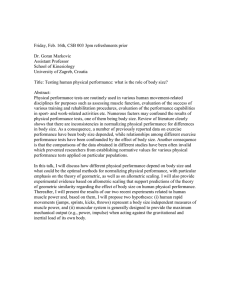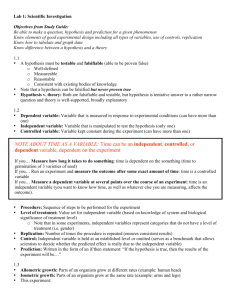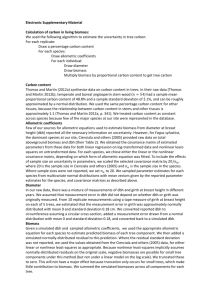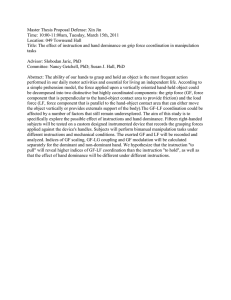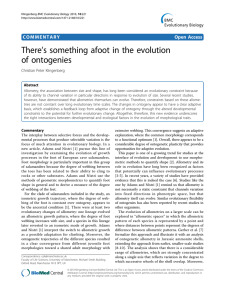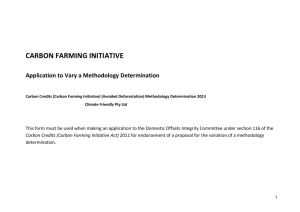Movement performance and body size: the relationship for different
advertisement
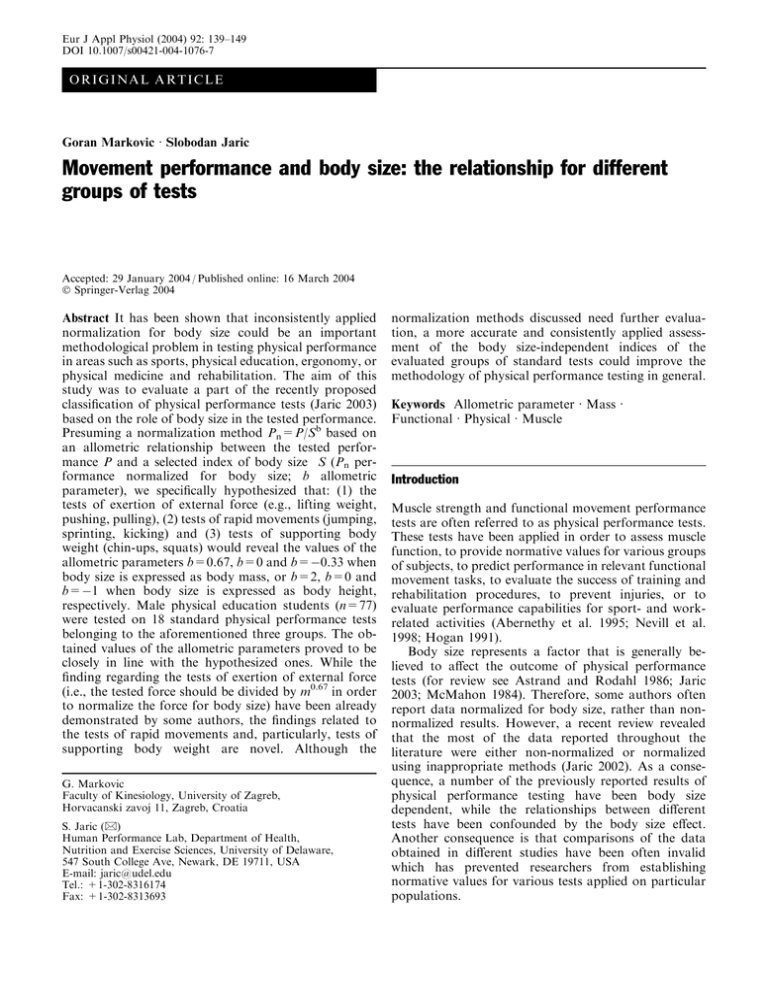
Eur J Appl Physiol (2004) 92: 139–149 DOI 10.1007/s00421-004-1076-7 O R I GI N A L A R T IC L E Goran Markovic Æ Slobodan Jaric Movement performance and body size: the relationship for different groups of tests Accepted: 29 January 2004 / Published online: 16 March 2004 Ó Springer-Verlag 2004 Abstract It has been shown that inconsistently applied normalization for body size could be an important methodological problem in testing physical performance in areas such as sports, physical education, ergonomy, or physical medicine and rehabilitation. The aim of this study was to evaluate a part of the recently proposed classification of physical performance tests (Jaric 2003) based on the role of body size in the tested performance. Presuming a normalization method Pn=P/Sb based on an allometric relationship between the tested performance P and a selected index of body size S (Pn performance normalized for body size; b allometric parameter), we specifically hypothesized that: (1) the tests of exertion of external force (e.g., lifting weight, pushing, pulling), (2) tests of rapid movements (jumping, sprinting, kicking) and (3) tests of supporting body weight (chin-ups, squats) would reveal the values of the allometric parameters b=0.67, b=0 and b=0.33 when body size is expressed as body mass, or b=2, b=0 and b=1 when body size is expressed as body height, respectively. Male physical education students (n=77) were tested on 18 standard physical performance tests belonging to the aforementioned three groups. The obtained values of the allometric parameters proved to be closely in line with the hypothesized ones. While the finding regarding the tests of exertion of external force (i.e., the tested force should be divided by m0.67 in order to normalize the force for body size) have been already demonstrated by some authors, the findings related to the tests of rapid movements and, particularly, tests of supporting body weight are novel. Although the G. Markovic Faculty of Kinesiology, University of Zagreb, Horvacanski zavoj 11, Zagreb, Croatia S. Jaric (&) Human Performance Lab, Department of Health, Nutrition and Exercise Sciences, University of Delaware, 547 South College Ave, Newark, DE 19711, USA E-mail: jaric@udel.edu Tel.: +1-302-8316174 Fax: +1-302-8313693 normalization methods discussed need further evaluation, a more accurate and consistently applied assessment of the body size-independent indices of the evaluated groups of standard tests could improve the methodology of physical performance testing in general. Keywords Allometric parameter Æ Mass Æ Functional Æ Physical Æ Muscle Introduction Muscle strength and functional movement performance tests are often referred to as physical performance tests. These tests have been applied in order to assess muscle function, to provide normative values for various groups of subjects, to predict performance in relevant functional movement tasks, to evaluate the success of training and rehabilitation procedures, to prevent injuries, or to evaluate performance capabilities for sport- and workrelated activities (Abernethy et al. 1995; Nevill et al. 1998; Hogan 1991). Body size represents a factor that is generally believed to affect the outcome of physical performance tests (for review see Astrand and Rodahl 1986; Jaric 2003; McMahon 1984). Therefore, some authors often report data normalized for body size, rather than nonnormalized results. However, a recent review revealed that the most of the data reported throughout the literature were either non-normalized or normalized using inappropriate methods (Jaric 2002). As a consequence, a number of the previously reported results of physical performance testing have been body size dependent, while the relationships between different tests have been confounded by the body size effect. Another consequence is that comparisons of the data obtained in different studies have been often invalid which has prevented researchers from establishing normative values for various tests applied on particular populations. 140 We recently proposed a classification of physical performance tests from the perspective of the normalization methods recommended for providing body size independent indices of various groups of performance (Jaric 2003; Jaric et al., submitted). The proposed classification was based on both the theoretical (the effect of scale based on presumed geometric similarity; Astrand and Rodahl 1986; McMahon 1984) and empirical observations (for review see Jaric 2002, 2003). In order to evaluate a part of our classification regarding muscle strength tests, we recently tested the relationship between various muscle strength tests and body size. The evaluated normalization method was based on an allometric approach that presumes normalized index of physical performance: Pn ¼ P =S b ; ð1Þ where P is the tested performance, S is body mass or, alternatively, any selected index of body size, while b is the allometric parameter. The results suggested that the allometric parameters for muscle force (e.g., a force tested by a dynamometer) and muscle torque (tested by a standard isokinetic apparatus) could be close to the theoretically predicted b=2/3=0.67 and b=1, respectively, when body mass was the selected index of body size (Jaric et al. 2002a, 2002b). These values mean that the body size independent index of muscle force obtained from the tested muscle group should be presented per kg2/3, while the same index of maximum torque should be assessed per kg1 of body mass. Another study revealed that various indices of rapid force/torque production could be either muscle strength (or, indirectly, body size) independent, or muscle strength dependent (Mirkov et al. 2004). Since muscle strength is related to body size per se, we concluded that some standard indices of rapid force/torque production could also be related to body size. The aforementioned results were not only in line with the proposed classification of the physical performance tests regarding the role of body size, but also supported by theoretical (Astrand and Rodahl 1986; Batterham and George 1997; McMahon 1984) and some experimental findings of other authors (for reviews see Jaric 2002; Sleivert and Wenger 1994; Wilson and Murphy 1996). However, a part of the proposed classification regarding functional movement tests also needs to be evaluated. In particular, we suggested b=0.67 for the tests of exertion of external force (e.g., lifting weights, pushing, pulling), b=0 for the tests of rapid movements (jumping, running, throwing, kicking), and b=0.33 for the tests of supporting body weight (push-ups, pull-ups, maintaining strengthdemanding postures in gymnastics or yoga). The concept that the exerted external force increases at a lower rate than body mass (implying b<1) has been supported by some of the previous studies, although the values of the obtained allometric parameter proved to be partly inconsistent (Challis 1999; Batterham and George 1997; Jaric et al. 2002b). The suggested b=0.67 has been explained by the effect of scale based on the presumption of geometric similarity. In short, since muscle force should be proportional to the muscle cross- or physiological-section area (linear dimensions squared L2), while body mass increases with body volume (means proportional to L3), the allometric coefficient for the ratio of force and body mass should be b=2/3=0.67 (for review see McMahon 1984; Astrand and Rodahl 1986; Jaric 2003). However, the relationships of either the tests of rapid movements or the tests of supporting body weight with body size seem to be both less apparent and rarely evaluated within the professional literature. Although some simple theoretical models (Hill 1950; McMahon 1984), as well as our general experience suggest no relationship between the performance of rapid movements and body size, comparison of animal performance on a much wider scale of body sizes (see McMahon 1984 for review) and some particular findings (e.g., sprinters are on average taller and heavier than long distance runners) suggest that there may be a weak positive relationship between the performance of rapid movements and body size. Regarding the tests of supporting body weight, a simple theoretical analysis suggests that the tested performance could decrease with body size. Namely, muscle force increases with size at the lower rate (i.e., proportionally to L2m0.67; see previous text) than body weight which is proportional to body mass (means L3m1). As a result, the ability to support own body weight in strength-demanding postures and movements should be proportional to m0.671=m0.33 suggesting b=0.33. Although the results of this simple theoretical analysis seems acceptable (see Astrand and Rodhal 1986 and Jaric 2002 for similar approaches), and while the small stature of elite gymnasts and acrobats is a well-known phenomenon, we could not find a single published study that presented normalized performance obtained from this group of tests. In order to address these problems, we designed an experiment in order to evaluate the relationship between the various results of a number of frequently applied tests of physical performance of movement performance and body size. The experiment involved testing the performance in a number of the tests of exertion of external force, the tests of rapid movements, and the tests of supporting body weight. In order to avoid potential confounding effects (for details see Discussion), we selected a rather homogeneous group of physically active subjects, who were also familiar with the tests applied. We hypothesized that the relationship between the tested performance and body size would be in line with the proposed classification of the physical performance tests. In particular, we expected that the tests of exertion of external force, the tests of rapid movements, and the tests of supporting body weight would reveal that the normalization of their performance for body size (as assessed by body mass) should be based on the allometric parameters b=0.67, b=0 and b=0.33, respectively. However, there is some evidence that the presumption of geometric similarity might lead to somewhat inaccu- 141 rate results when applied in normalization models and procedures. For example, the allometric parameter that relates surfaces (e.g., muscle cross-section area) or surface-related indices (e.g., maximal oxygen uptake, or resting metabolic rate) to body mass could be closer to b=3/4=0.75 than to the b=2/3=0.67 predicted by geometric similarity (Kleiber 1932; Brody 1945; West et al. 1997; Jensen et al. 2001; Weibel 2002). This former value could be partly explained by the effect of scale based on the presumably more accurate elastic similarity or, alternatively, constant stress similarity (see McMahon 1984 for review). The consequence could be that the relationship between the most often applied indices of body size [i.e., body mass (m) and body height (H)] could not be exactly H3m1, as predicted by the geometric similarity. Therefore, in addition to body mass, we also related the tested performance to body height. Note that if the relationship between body mass and height is H3m1 as predicted by geometric similarity, the hypothesized values of the allometric parameter for body mass (see previous paragraph) would lead to three times higher values of the same parameters for body height. Methods Participants Seventy-seven male physical education students (ages 18–26 years) participated in the study. All subjects regularly participated in courses of physical activities on a daily basis through their standard academic program, while 14 of them were also national or international level athletes in either individual (mainly karate and swimming) or team sports (handball, volleyball, soccer and water polo). None of them reported health problems or recent injuries. It is important to stress that they were familiar with most of the tests applied due to regular semi-annual testing of their physical abilities, as well as their participation in various sport activities through their academic curriculum. The measurement procedures and potential risks were verbally explained to each participant prior to obtaining a written informed consent according to the Helsinki Declaration. Experimental design Participants were assigned to three groups approximately equal in size. Each group was tested between 10 a.m. and 1 p.m. in six separate experimental sessions separated by the number of days required for the same tests to be performed on the two remaining groups. As a consequence, the rest period between two consecutive sessions for the same group was either 3 or 5 days (if it covered weekends). Each experimental session was preceded by a standard warm-up and stretching procedure. Since each experimental session covered three tests, the experiment was conducted over six sessions. Although the subjects were familiar with virtually all the tests though their regular activity courses, each test was demonstrated by a qualified person. Thereafter, the subjects had either two (for rapid movement tests), or one (for isometric squat and hand grip tests), or no practice trials (all remaining tests) prior to the testing procedure. The tests that required repetition were performed with 2- to 3-min rest periods, while the pause between two consecutive tests was approximately 5 min. The selection and the sequence of three consecutive tests performed within a single experimental session were aimed to avoid the effects of fatigue caused by preceding test. Anthropometric data Anthropometric measures were taken according to the procedures recommended by the International Biological Program (Weiner and Lourie 1969). Body height and body mass were measured to the nearest 0.5 cm and 0.1 kg, respectively. Body composition was assessed through the estimation of body density using skinfold measurements (Jackson and Pollock 1978) taken at abdominal, chest and thigh sites by an experienced experimenter. Skinfolds were measured in triplicate for all sites and the median of the three values was taken for further analysis. The percent body fat was calculated using a previously recommended method (Siri 1956). Tests of exertion of external force Isometric squat test A modified testing procedure applied previously (Wilson et al. 1993) was used to measure isometric squat strength (see Fig. 1 for illustration). A squat rack was secured into the floor above the force platform (Kistler, Winterthur, Switzerland). An olympic bar was fixed at a selected point above the force plate with an accuracy of 2 cm by means of mechanical stops. The subject was positioned in the squat rack with the heels directly under the bar and the angle of the knee was set to 120° (Young 1995). This angle is within the range reported to produce the maximum force of knee extensors (Kulig et al. 1984). The subject was instructed to gradually exert force until no further increase was detected (Young 1995). All subjects wore a weightlifting belt during the test. The force plate was reset to zero prior to the test in order to cancel out the subject’s weight (Wilson et al. 1993). The force was sampled at a rate of 500 Hz over 5 s following the initiation of the contraction. The test was repeated two times, and the better trial was taken for further analysis. Grip strength Maximum grip strength was assessed by means of a standard hand grip dynamometer (Lafayette Instrument Co., USA) with demonstrated high reliability and validity (Mathiowetz et al. 1984). The subject was standing with the tested arm extended vertically beside the body. The dynamometer was adjusted for each subject such that the angle of flexion of the middle finger at the second joint from the tip was as close to 90° as possible. The tested wrist was maintained in neutral position and the forearm was fully extended at the elbow joint. The result was recorded in N. The subject performed three trials with each hand and the average result of the best trials for each hand was taken for further analysis. 1RM back squat The maximal back squat test was slightly modified from the protocol previously described (McBride et al. 2002). The test was performed using a standard Smith machine (Gym 80 International, Germany). Each subject was instructed to lower the bar to the point where the knee angle was 80°, which was marked by adjustable mechanical stops (McBride et al. 2002). All subjects wore a weightlifting belt during the test. Two experienced spotters assisted during the testing. Before testing the participant’s 1RM squat, a number of warm-up trials were given as follows: 30% (8 repetitions), 50% (5–6 repetitions), 75% (3 repetitions), and 90% (1 repetition) of an estimated 1RM. Since each participant had at least 1 year of experience of training with free weights, the approximate value of 1RM was known in advance. After 90% of 1RM, loads were increased using small plates (5 kg, 2.5 kg and 1.25 kg) until 1RM was reached. Adequate rest was allowed between trials (3–5 min). The process of assessment of 1RM 142 Fig. 1 An illustration of the applied tests of exertion of external force (upper row), rapid movements (middle row), and supporting body weight (lower row) maximal squat generally required no more than 4–5 lifts in order to be complete. The movement speed of this test, as well as of the remaining tests was not controlled. movement phase which included pushing the bar until his elbows were fully extended, while maintaining the proper position of the arms and the body. The spotter stood aside and kept his hands under the bar to protect the subject’s head. Both the procedure and sequence of the warm-up and testing trials were the same as for testing the 1RM maximal squat. 1RM standing biceps curl 1RM bench press The bench press test was conducted on a Smith machine (Gym 80 International, Germany) according to the standard method used by Murphy et al. (1994). Briefly, the subject lowered the bar to the chest and, thereafter, raised it until his elbows were fully extended (see Murphy and Wilson 1996 for details). The procedure and sequence of the warm-up and testing trials were the same as for testing the 1RM maximal squat. 1RM triceps extension The triceps extension test was performed similarly to the protocol previously described (Baechle et al. 1994; Abernethy and Jurimae 1996). In short, the subject performed the test while lying supine on a horizontal bench while keeping his feet on the floor. The subject grasped the bar with the closed overhand grip with his hands approximately 25–30 cm apart and held it above his shoulders. The arms were parallel to each other, perpendicular to the floor. The downward movement phase included lowering the bar slowly to the forehead, while keeping the upper arms parallel and perpendicular to the floor. After that, subject performed the upward The standing biceps curl test has been often used for the purpose of both training and testing of elbow flexor strength (e.g., Baechle et al. 1994; Bompa and Cornacchia 1998). The subject was standing in natural erect position with the trunk positioned against the wall in order to exclude trunk swing movements during the test. He held the bar in the low position using supinated grip slightly wider than the shoulder width with the elbows extended. The upward movement phase consisted of flexing the elbows, while maintaining the posterior side of the body in contact with the wall and keeping the shoulder and wrist angle constant. The trial was considered successful if the subject was able to raise the bar to within 15 cm of the anterior deltoids, (Baechle et al. 1994). The procedure and sequence of the warm-up and testing trials were the same as for testing the 1RM maximal squat. Tests of rapid movements Standing long jump The long jump from a standing position with arm swing (Horita et al. 1991) was tested by means of a jump mat (Elan, Slovenia). The distance from the starting point to the landing point at heel 143 contact was used as the result. Each subject performed three trials and the best result was taken for further analysis. Squat jump A vertical jump was performed on a force platform (Kistler Instrumente AG, Switzerland) from a semi-squat position, while the arms were held akimbo in order to avoid arm swing (Komi and Bosco 1978). The jump height was assessed as the maximum displacement of the center of mass calculated from the vertical component of the recorded force and body weight. Each subject performed three jumps and the best result was used for further analysis. Counter-movement jump The technique used was the same as previously described, but subjects were instructed to perform an unconstrained vertical jump from the standing upright position that includes the initial counter movement, but not the arm swing (Komi and Bosco 1978). Sprints over 20 m Sprints over a distance of 20 m (previously used to measure sprint acceleration ability, McBride et al. 2002) were performed from a standing start and measured by means of infrared photocells (RS Sport, Zagreb, Croatia). The subject was initially standing with his rear (swing) leg on a contact mat. He was instructed to accelerate as quickly as possible through the timing gate positioned 20 m from the starting line. Moving the rear leg from the contact mat initiated a digital timer (resolution 1 ms). Each subject performed three trials and the best result (i.e., the shortest time) was taken for further analysis. Standing ball kick The subject was instructed to kick a soccer ball (mass 0.450 kg) with his dominant leg without a run-up. The subject was standing with the non-dominant leg aside the stationary ball and, following the natural preparatory swing of the kicking leg, kicked the ball as fast as possible towards a net. The subject was instructed to kick the ball as fast as possible towards a specified direction. Maximum ball velocity (m s1) was measured using a calibrated Professional Radar Gun (Stalker, Applied Concept Marketing, USA). The test was repeated three times and the best result was taken for further analysis. Throwing a ball The subject was in a seated straddle position on the floor, with the handball (mass 0.425 kg) in the dominant hand placed overhead. The other arm was placed on the floor beside the body. The subject was instructed to throw the ball with the maximum velocity towards the specified direction. Maximum ball velocity (m s1) was recorded by the same radar gun used in the previous test. The test was repeated three times and the best result was taken for further analysis. Tests of supporting body weight Sit-ups A standard procedure for the 1-min bent-knee sit-up test was applied (Semenick 1994). The subject lay supine on a gymnastic mat with his knees bent and feet fixed on the floor 25–30 cm apart. The subject’s fingers were interlocked behind the neck, and the backs of the hands touched the mat. The sit-up was correctly completed when the elbows touched the thighs and the subject returned to the starting position until the upper portion of the back made contact with the mat. The number of sit-ups correctly completed in 1 min became the score. Push-ups A previously suggested procedure for the 1-min push-up test (Semenick 1994) was applied. It required the subject to take the standard push-up position (feet positioned less that 30 cm apart, hands beside the chest with fingers pointing forward, and the legs, back, neck and head positioned along a straight line). On the go signal, the subject initiated consecutive sequences of lowering the body until the upper arms were parallel to the ground and thereafter returning to the starting position until the elbows were fully extended. The body configuration had to remain unchanged over the entire cycle. The number of the push-ups correctly completed in 1 min became the score. Pull-ups The starting position of the pull-up test (Baumgartner and Jackson 1995) required the subject to position his hands on the bar with palms facing away, shoulder-width apart, and to keep the arms in a fully extended hanging position. The subject was asked to pull himself up until his chin was above the bar and, thereafter, to return back to the fully extended hanging position. The pull-up bar was positioned to a height sufficient to prevent the feet touching the floor. No swinging movement of any part of the body was allowed during the performance of pull-ups. The maximum number of correctly performed pull-ups became the score. Parallel bar dips The procedure required the subject to be positioned on the parallel bars with his arms locked and the body vertically oriented (Schmidt 1999). Thereafter, the subject was instructed to lower himself until the upper arms became horizontally oriented and, thereafter, to lift himself back to the arms locked position. The maximum number of parallel bar dips correctly performed became the score. One-leg rising A modified procedure of Ostenberg at al. (1998) for the measurement of one-leg rising was used. The subject was standing with his dominant leg on a box while the other leg was extended vertically beside the box. The height of the box was adjusted for each subject individually such that the upper thigh of the dominant leg reached the horizontal position when the heel of the non-dominant leg touched the ground at the end of the squatting movement. The subject was instructed to lower himself until his heel touched the ground and, thereafter, to rise back to the standing position. No rests in the lowest position were allowed. The maximum number of correctly performed trials became the score. Hanging leg raises The procedure applied (see Bompa and Cornacchia 1998 for details) required the subject to grasp the handles and support the body weight with the arms allowing the torso to hang down in a straight vertical line. The subject was instructed to raise his extended legs using the abdominal and hip flexor muscles until they reach horizontal position and, thereafter, to lower the legs back to the starting position. Swinging of legs prior to their raising was not allowed. The test was finished when the subject became unable to raise his legs to the horizontal position. The maximal number of the correctly performed leg raises became the score. 144 Data analysis Descriptive statistics were calculated for all experimental data. Percent body fat was assessed from the recorded skinfolds using standard methods (Jackson and Pollock 1978; Siri 1956). A regression technique applied on the log-transformed data provided the values of the allometric parameter b for each particular test (see Batterham and George 1997 and Davies and Dalsky 1997 for details of the method). In short, a log-transformation of the presumed allometric relationship (see Eq. 1) between a particular performance P and body mass S gives: log P ¼ log Pn þ b log S; ð2Þ where log Pn and b respectively correspond to the intercept and slope of the regression line fitted through the logarithmic values of the experimentally recorded performance and the selected index of body size/body mass. The values of the allometric parameter b obtained separately for body mass and body height were taken for further analysis. One-way ANOVA and Sheffe post hoc tests were employed in order to assess the differences among the values of the allometric parameters obtained in the three groups of tests. Averaged values of the allometric parameters obtained from particular groups of tests were also tested against the theoretical predictions using a one-group t-test. The level of statistical significance was set to P=0.05. Results The subjects’ mean (SD) body mass and height were 73.6 (7.5) kg and 1.80 (0.06) m, respectively. The measured skinfold thicknesses were 12.2 (5.6) mm, 7.0 (2.7) mm, and 12.3 (4.7) mm for the abdominal, chest and thigh measurements, respectively. When used for assessment of body composition, these values revealed 8.4 (3.6)% body fat. The following figure depicts the performance obtained in the bench press test plotted against body size/mass (Fig. 2A) and body height (Fig. 2B). As expected, the logtransformed indices of the performance tested and the body size suggest a positive relationship. The slopes of the regression lines obtained correspond to allometric parameters needed to assess body size independent indices of the performance tested (see parameter b in Eqs. 1 and 2). The parameters obtained in all 18 performance tests and assessed separately with respect to body mass and body height represent the main result of this study. The following three tables show descriptive data of all 18 physical performance tests applied (upper part), as well as the results of the linear regressions applied to the log-transformed individual performance of each particular test and the selected index of body size (lower part) (Tables 1, 2, 3). The main findings of the present study are related to the values of the allometric parameters b obtained from the three groups of physical performance tests, assessed separately for body mass (upper part) or body height (lower part). One-way ANOVA applied to the allometric parameters of the three groups of test data obtained with respect to body mass revealed F[2,5]=34 (P<0.05). The same result for the parameters obtained with respect to body height was F[2,5]=37 (P<0.05). The post-hoc test Fig. 2 Relationship between log-transformed bench press results and body mass (A) or body height (B) applied to both sets of data suggested significant differences among all three groups of tests. The correlation coefficients recorded between the log-transformed indices of body size and the performance obtained in each particular test proved, on average, to be moderate (see Tables 1, 2, 3). The tests of rapid movements demonstrated particularly low correlation coefficients and only the ball throwing tests provided significant correlation coefficients. Finally, the allometric parameters were averaged within each group of tests and compared with the hypothesized values. When obtained with respect to body mass (see the upper part of Table 4), the allometric parameters obtained from the tests of exertion of external force were not different from the theoretically predicted b=0.67, but significantly higher than b=0 (P<0.05). The allometric parameters obtained from the tests of rapid movements were not significantly different from the predicted b=0, but proved to be both higher than b=0.33 and lower than b=0.67 (P<0.05). Finally, the allometric parameters obtained from the tests of supporting body weight were somewhat lower than the theoretically predicted b=0.33, but the difference was below the level of significance (P=0.094). 145 Table 1 Tests of exertion of external force and their relationship to body mass and body height. The intercept is given as a while b is the allometric parameter that corresponds to the slope of the regression line ln(P)=a+b ln(S) where P represents the test performance and S the body mass or body height. R correlation coefficient Test Mean (SD) With respect to body mass With respect to body height a b R a b R Isometric squat (N) Back squat (kg) Bench press (kg) Triceps extension (kg) Biceps curl (kg) Hand grip (N) 2558 (654) 3.8 0.94 0.37* 0.44 1.70 0.23* 154 (21) 3.2 0.42 0.32* 2.47 0.13 0.03 77 (11) 1.4 0.69 0.50* 0.30 1.12 0.23* 32.2 (6.0) 0.96 0.58 0.33* 1.43 1.30 0.25* 39.4 (5.5) 0.87 0.65 0.48* 0.93 1.12 0.28* 534 (75) 2.8 0.27 0.21 0.68 1.07 0.25* *P<0.05 Table 2 Tests of rapid movements and their relationship to body mass and body height. The intercept is given as a while b is the allometric parameter that corresponds to the slope of the regression line ln(P)=a+b ln(S) where P represents the test performance and S the body mass or body height. R correlation coefficient Test Mean (SD) With respect to body mass With respect to body height a b R a b R Squat jump (cm) Counter-movement jump (cm) Standing long jump (cm) Standing ball kick (m s1) Throwing ball (m s1) Sprint 20 m (s) 42.3 (4.4) 3.8 0.01 0.01 1.89 0.11 0.04 46.7 (4.7) 4.0 0.03 0.03 2.11 0.20 0.07 233 (14) 5.6 0.03 0.06 2.56 0.09 0.05 20.2 (1.9) 3.7 0.13 0.14 2.25 0.18 0.07 14.4 (1.2) 2.4 0.36 0.43* 0.49 0.97 0.40* 3.22 (0.17) 0.96 0.05 0.10 0.14 0.28 0.19 *P<0.05 Table 3 Tests of supporting body weight and their relationship to body mass and body height. The number of completed trials is given as n. The intercept is given as a while b is the allometric Test Mean (SD) With respect to body mass With respect to body height a b R a b R parameter that corresponds to the slope of the regression line ln(P)=a+b ln(S) where P represents the test performance and S the body mass or body height. R correlation coefficient Sit-ups (n) Push-ups (n) Pull-ups (n) Parallel bar dips (n) One leg rising (n) Hanging leg raises (n) 55.9 (6.1) 5.3 0.30 0.27* 3.45 0.76 0.23* 43.2 (8.8) 5.5 0.42 0.20 5.69 1.80 0.29* 11.5 (4.1) 7.0 1.08 0.27* 6.39 2.38 0.20 19.1 (5.2) 5.3 0.55 0.20 4.55 1.46 0.18 33.6 (5.6) 5.7 0.51 0.31* 4.57 1.35 0.28* 43.4 (6.2) 5.4 0.38 0.27* 4.68 1.35 0.32* *P<0.05 Table 4 Comparison of the averaged values of allometric parameters mean (SD) with those predicted *Significantly different from the predicted value (P<0.05) With respect to body mass With respect to body height Tests of exertion of external force Tests of rapid movements Tests of supporting body weight Obtained Predicted Obtained Predicted 0.59 (0.23) 0.67 1.03* (0.61) 2 0.07 (0.15) 0 0.11 (0.46) 0 When obtained with respect to body height (lower part of Table 4), the allometric parameters obtained from the tests of exertion of external force were lower than the theoretically predicted b=2, but significantly higher than b=0 (P<0.05). The allometric parameters 0.54 (0.28) 0.33 1.51 (0.54) 1 obtained from the tests of rapid movements were not significantly different from the predicted b=0, but proved to be both higher than b=1 and lower than b=2 (P<0.05). Finally, the allometric parameters obtained from the tests of supporting body weight were 146 somewhat lower than the theoretically predicted b=1, but the difference was below the level of significance (P=0.067). Discussion Factors affecting performance-size relationship The main aim of the present study was to estimate the values of the allometric parameters that could be used for normalization for body size of the evaluated groups of physical performance tests. However, it should be pointed out that factors, such as age, gender, level of physical activity and body composition, could also affect physical performance and therefore confound the relationship between the tested performance and body size we have studied (Abernethy et al. 1995; Challis 1999; Davis and Dalsky 1997; Izquierdo et al. 2001; Nevill et al. 1998). Since these factors are subject-related, they cause the relationship between the physical performance and the body size to be not only test-specific, but also subject-specific (Abernethy et al. 1995; Jaric 2002). As a consequence, the relationships obtained in different subject populations have been inconsistent causing an important obstacle for establishing standard methods for the normalization of physical performance for body size (Jaric 2003; Jaric et al., submitted; Wilson and Murphy 1996). From the perspective of the problem discussed, it is important to stress that our subjects represented a relatively homogeneous group of participants. Specifically, they were of a similar age and physically highly active. Since body composition could also affect the relationship between body size and physical performance, it is important to stress that the skinfolds obtained from the subjects we tested suggested a low percent of fat tissue, which was comparable to those measured in trained male distance runners (Willmore 1983) and wrestlers (McArdle et al. 1999). Finally, although the number of subjects we tested was somewhat below that generally recommended for this type of study (i.e., n>100; Jensen et al. 2001), it considerably exceeded the number of participants in most of the similar studies (see Wilson and Murphy 1996 and Jaric 2002 for reviews). They were also quite familiar with virtually all the tests applied. Therefore, we believe that the present study provides a valid set of data due to the relatively large and partly homogeneous sample of subjects tested, as well as due to their high level of familiarity with the tests used. Allometric parameters obtained The main finding of the present study is that the most of the experimentally obtained values of the allometric parameters are closely in line with the values hypothesized for different groups of tests in each of the three groups of tests. However, the predictions obtained with respect to both body mass and body height are based on the same theoretical background, while only body mass has been frequently used for normalization of the physical performance tested. Therefore, most of our discussion will be focused on the findings related to the values of the allometric parameters obtained with respect to body mass. Regarding the tests of exertion of external force, the results were as expected. Despite prominent inconsistencies in the previously reported data (for reviews see Challis 1999; Jaric 2002; Wilson and Murphy 1996), the average value of the allometric parameter obtained across the tests for b=0.59 is in line with the generally accepted concept that performance for lifting weight (Batterham and George 1997; Challis 1999; McMahon 1984) or static exertion of external force (Aasa et al. 2003; Davies and Dalsky 1997; Jaric 2003) increase at a somewhat lower rate than body mass. Regarding the remaining two groups of physical performance tests, a review of the literature provides less compelling evidence. Most of the tests of various rapid movements have been presented with non-normalized data, implying the theoretically suggested b=0 (Aasa et al. 2003; Jaric 2002; Matavulj et al. 2001; Ugarkovic et al. 2002). However, a possible positive relationship between the outcome of these tests and body size (although presumably weak; for review see McMahon 1984) has not been discussed, neither have experimental studies been designed to answer this specific question. Moreover, some authors suggest a moderate positive correlation between movement velocity and body size (Vanderburgh et al. 1996), while others even present jumping performance per kilogram of body mass implying b=1 (e.g., Benefice 1992). Therefore, it appears that the consensus among professionals has not been reached regarding either whether or how to normalize the performance of rapid movements for differences in body size. The effect of scale predicts the experimentally obtained negative relationship between the tests of supporting body weight under strength-demanding movement conditions and body size. In addition to both theoretical and empirical findings (see Introduction), some recent experimental findings also speak in favor of the hypothesized phenomenon (Aasa et al. 2003). However, this relationship appears to be entirely neglected within the professional literature. Therefore, application of the findings regarding the specific normalization methods for the tests of supporting body weight, as well as of the previously discussed tests of rapid movements, could considerably improve the methodology of testing of physical performance in the future. An important limitation of the approach applied could originate from the problem that some physical performance tests may not belong only to one particular group. While lifting a weight the subject not only exerts external force (the recommended allometric parameter with respect to body mass is b=0.67), but also supports 147 weight of his/her own body segments (b=0.33). Similarly, kicking and throwing require exerting external force against a ball (b=0.67), while the rapid limb movements require b=0. As a result, the allometric parameters for some tests could be somewhere between the particular values we specifically evaluated. This assumption is in line with a relatively high value of the allometric coefficient (comparing to other tests of rapid movements) we obtained from the ball throwing test (see Table 2). Some tests may also be confounded by other factors, such as movement skills or endurance. Therefore, both the present findings and our previously proposed classification (Jaric 2003) may need further evaluation. The main difficulty in this evaluation may be the moderate relationship between the performance tested and body size observed in both the present and previous studies (for review see Abernethy et al 1995; Jaric 2002; Wilson and Murphy 1996). ‘‘Structure’’ of movement abilities and the effect body size An important purpose of testing of physical abilities is the profiling of various groups of subjects, such as athletes of different specialization, children of different ages, or various groups of patients (Andersson et al. 1988; Jaric et al. 2001; Neder et al. 1999; Sleivert et al. 1995; Ugarkovic et al. 2002). However, different tests applied on the same subjects have been also related amongst themselves in order to assess partly independent components of physical abilities. For example, the review by Hogan (1991) suggests that the tests based on exertion of force (maximal push, pull, dynamometric forces) and the tests based on body movement tasks (leg lifts, push-ups) belong to independent abilities (i.e., the correlations between them are low, particularly when compared to the correlations obtained among the tests belonging to the ‘‘same abilities’’). As a result, these abilities are believed to require separate tests in order to be evaluated. Probably the most famous structure of physical abilities is the one based on comprehensive testing performed during the 1950s and 1960s (see Fleishman 1964 for a review). Among others, this structure suggests ‘‘static strength’’ (exerting forces, lifting weights), ‘‘explosive strength’’ (running, jumping) and ‘‘dynamic strength’’ (push-ups, squats) as independent physical abilities. A number of comprehensive testing batteries have been designed taking into account either this or other similar structures of physical abilities (Marsh 1993; Simons et al. 1982), including the comprehensively used EUROFIT test (Eurofit 1988). However, note that the aforementioned ‘‘abilities’’ (Fleishman 1964; Hogan 1991) closely correspond to the evaluated tests of exertion of external force, tests of rapid movements, and tests of supporting body weight. According to the present findings, these tests are likely to be differently related to body size, while the proposed ‘‘structures of physical abilities’’ were exclusively based on non-normalized indices of the tested performance. As a result, it appears that the suggested structures could partly represent an artifact of the confounding effect of body size. For example, it is likely that the subjects that performed relatively better in the tests of ‘‘static strength’’ were on average taller and heavier that those who performed relatively better in ‘‘dynamic strength’’ tests. This assumption is in line with some of the more recent findings suggesting that lighter subjects may be less capable in exerting external forces (e.g., lifting weights, throwing heavy objects), but more successful in overcoming their own weight (Aasa et al. 2003; Barnekow-Bergkvist et al. 1996; Schmidt 1999). Therefore, one could conclude that the formerly proposed structures of physical abilities should be thoroughly re-evaluated by using more accurately calculated body size independent indices of the performances tested. This could eventually lead to re-designing standard batteries of routine physical performance tests applied on particular populations, such as children of different ages, soldiers, or the elderly. Theoretical considerations Although the present study is mainly focused on the neglected issue of normalization for body size of some groups of frequently applied physical performance tests, some theoretical considerations regarding the applied methodology also deserve attention. In particular, the presumption of geometric similarity that led to the hypothesized specific values of the allometric parameters evaluated in the present study has been often questioned (see the last paragraph of Introduction for details). A distorted relationship between surface and body mass or volume (i.e., b=0.75 instead of b=0.67; Brody 1945; Kleiber 1932; West et al. 1997; Weibel 2002) would inevitably lead to a distorted relationship between linear dimensions (e.g., body height) and body mass. Among other consequences, the predicted allometric coefficients for the normalization of performance obtained in the tests of exertion of external force and the tests of supporting body weight would be somewhat higher than b=0.67 and lower than b=0.33, respectively. The relationship between body mass and height would also be H8/3m1 instead of H3m1 (McMahon 1984, Nevill et al. 2004) suggesting that the allometric parameters for the three groups of tests evaluated with respect to body height should be lower than those predicted (see Table 4 for specific values). Our results provide some inconsistent findings regarding the theoretical problem we discuss. For example, most of the allometric parameters obtained for body height proved to be less than three times higher than those obtained with respect to body mass, while the allometric parameter for tests of supporting body weight is somewhat below b=0.33 (see Table 4). These findings are in line with scaling based on ‘‘elastic similarity’’ (McMahon 1984) and a fractal network model 148 (West et al. 1997). However, the same theoretical framework suggests b=0.75 for the tests of exertion of external force, while it appears to be below b=0.67 as predicted by geometric similarity. Except for the body height related allometric parameters of the tests of exertion of external force being significantly lower that b=2 (as predicted by geometric similarity), none of other findings provided a statistically significant effect. The main cause could be the relatively narrow scale of human body sizes, as well as a number of confounding factors affecting the performance-size relationship (for reviews see Abernethy et al 1995 and Jaric 2002). As a consequence, the relationships between the tested performance and body size are on average moderate, while the allometric parameters obtained within the tests of the same group are partly inconsistent (see data for individual tests in Tables 1, 2, 3). Therefore, our data may not be appropriate for a comprehensive evaluation of different scaling approaches. We believe that further theoretical research, as well as the experimental research conducted on a much wider scale of animal body sizes, is needed in order to provide answers regarding the accurate scaling of body dimensions, rather than the results obtained through comprehensive testing of physical performance in humans. Conclusions The results obtained on a large and homogeneous group of subjects strongly support the recently proposed classification of physical performance tests based on particular allometric parameters recommended for normalization of various groups of tests for body size. In particular, it appears that the performance of the tests of exerting external force should be presented per kg2/3 (i.e., b=0.67), the results of the tests of supporting body weight under strength-demanding conditions should be multiplied by kg1/3 (b=0.33), while the performance of the tests of rapid movements needs no normalization (b=0). Although the recommended methods may need further evaluation, it seems conceivable that a standardized and consistently applied normalization for the effect of body size, such as that specifically proposed in the present study, could considerably improve the methodology of physical performance testing. Among other benefits, it would provide body size independent performance indices for a number of frequently applied performance tests that could be both compared with other studies and used to establish standards for particular tests and particular populations, as well as provide a basis for future improvement of the standard batteries of physical performance tests. Acknowledgements The authors would like to thank Dr. Metikos for valuable comments and suggestions. This study was supported in part by grants from the Croatian Ministery of Science and Technology Education (0034217) and from Serbian Research Council (1758). References Aasa U, Jaric S, Barnekow-Bergkvist M, Johansson H (2003) Muscle strength assessment from functional performance tests: role of body size. J Strength Cond Res 17:644–670 Abernethy PJ, Jürimäe J (1996) Cross-sectional and longitudinal uses of isoinertial, isometric, and isokinetic dynamomety. Med Sci Sports Exerc 28:1180–1187 Abernethy P, Wilson G, Logan P (1995) Strength and power assessment. Issues, controversies and challenges. Sports Med 19:401–417 Andersson E, Sward L, Thorstensson A (1988) Trunk muscle strength in athletes. Med Sci Sports Exerc 20:587–593 Astrand P-O, Rodahl K (1986) Textbook of work physiology, 3rd edn. McGraw-Hill, New York Baechle TR, Earle RW, Allerheiligen WB (1994) Strength training and spotting techniques. In: Baechle TR (ed) Essentials of strength training and conditioning. Human Kinetics, Champaign, pp 345–400 Barnekow-Bergkvist M, Hedberg G, Janlert U, Jansson E (1996) Development of muscular endurance and strength from adolescence to adulthood and level of physical capacity in men and women at age of 34 years. Scand J Med Sci Sports 6:145–155 Batterham AM, George KP (1997) Allometric modelling does not determine a dimensionless power function ratio for maximal muscular function. J Appl Physiol 83:2158–2166 Baumgartner T, Jackson A (1995) Measurement for evaluation in physical education and exercise science. Brown and Benchmark, Madison Benefice E (1992) Growth and motor-performance of healthy Senegalese preschool children. Am J Hum Biol 4:717–728 Bompa T, Cornacchia L (1998) Serious strength training. Human Kinetics, Champaign Brody S (1945) Bioenergetics and growth. Reinhold, New York Challis JH (1999) Methodological report: the appropriate scaling of weightlifting performance. J Strength Cond Res 13:367–371 Davies MJ, Dalsky GP (1997) Normalizing strength for body size differences in older adults. Med Sci Sports Exerc 29:713–717 Eurofit (1988) European tests of physical fitness. Council of Europe, Committee for the Development of Sport, Rome, Italy Fleishman EA (1964) The structure and measurement of physical fitness. Englewood Cliffs, Prentice-Hall, NewYork Hill AV (1950) The dimensions of animals and their muscular dynamics. Sci Prog 38:209–230 Hogan J (1991) Structure of physical performance in occupational tasks. J Appl Psychol 76:495–507 Horita T, Kitamura K, Kohno N (1991) Body configuration and joint moment analysis during standing long jump in 6-year-old children and adult males. Med Sci Sports Exerc 23:1068–1072 Izquierdo M, Hakkinen K, Anton A, Garrues M, Ibanez J, Ruesta M, Gorostiaga EM (2001) Maximal strength and power, endurance performance, and serum hormones in middle-aged and elderly men. Med Sci Sports Exerc 33:1577–1587 Jackson AS, Pollock ML (1978) Generalized equations for predicting body density of men. Br J Nutr 40:497–504 Jaric S (2002) Muscle strength testing: the use of normalization for body size. Sports Med 32:615–631 Jaric S (2003) Role of body size in the relation between muscle strength and movement performance. Exercise Sport Sci Rev 31:8–12 Jaric S, Ugarkovic D, Kukolj M (2001) Anthropometric, strength, power and flexibility variables in elite male athletes: basketball, handball, soccer and volleyball players. J Hum Mov Stud 40:453–464 Jaric S, Ugarkovic D, Kukolj M (2002a) Evaluation of methods for normalizing strength in elite and young athletes. J Sports Med Phys Fitness 42:141–151 Jaric S, Radosavljevic-Jaric S, Johansson H (2002b) Muscle force and muscle torque may require different methods when adjusting for body size. Eur J Appl Physiol 87:304–307 149 Jensen K, Johansen L, Secher NH (2001) Influence of body mass on maximal oxygen uptake: effect of sample size. Eur J Appl Physiol 84:201–205 Kleiber M (1932) Body size and metabolism. Hilgarida 6:315–353 Komi PV, Bosco C (1978) Utilisation of stored elastic energy in leg extensor muscles by men and women. Med Sci Sports 10:261– 265 Kulig K, Andrews JG, Hay JG (1984) Human strength curves. Exerc Sport Sci Rev 12:417–466 Marsh HW (1993) The multidimensional structure of physical fitness: invariance over gender and age. Res Q Exerc Sport 64:86– 95 Matavulj D, Kukolj M, Ugarkovic D, Tihanyi J, Jaric S (2001) Effects of plyometric training on jumping performance in junior basketball players. J Sports Med Phys Fitness 41:159– 164 Mathiowetz V, Weber K, Volland G, Kashman N (1984) Reliability and validity of hand strength evaluation. J Hand Surg 9A: 222–226 McArdle, WD, Katch FI, Katch VL (1999) Sports and exercise nutrition. Lippincott Williams & Wilkins, Baltimore McBride JM, Triplett-McBride T, Davie A, Newton RU (2002) The effect of heavy versus light-load jump squats on the development of strength, power and speed. J Strength Cond Res 16:75–82 McMahon TA (1984) Muscles, reflexes and locomotion. Princeton, Princeton Mirkov D, Nedeljkovic A, Milanovic S, Jaric S (2004) Muscle strength testing: evaluation of tests of explosive force production. Eur J Appl Physiol 91:147–154 Murphy AJ, Wilson GJ (1996) The assessment of human dynamic muscular function: a comparison of isoinertial and isokinetic tests. J Sports Med Phys Fitness 36:169–177 Murphy AJ, Wilson GJ, Pryor JF (1994) The use of the isoinertial force mass relationship in the prediction of dynamic human performance. Eur J Appl Physiol 69:250–257 Neder JA, Nery LE, Silva AC, Andreoni S, Whipp BJ (1999) Maximal aerobic power and leg muscle mass and strength related to age in non-athletic males and females. Eur J Appl Physiol 79:522–530 Nevill AM, Holder RL, Baxter-Jones A, Round JM, Jones DA (1998) Modeling developmental changes in strength and aerobic power in children. J Appl Physiol 84:963–970 Nevill AM, Stewart AD, Olds T, Holder R (2004) Are adult physiques geometrically similar? The dangers of allometric scaling using body mass power laws. Am J Phys Anthropol (in press) Ostenberg A, Roos E, Ekdahl C, Roos H (1998) Isokinetic knee extensor strength and functional performance in healthy female soccer players. Scand J Med Sci Sports 8:257–264 Schmidt D (1999) Strength and physiological characteristics of NCAA division III American football players. J Strength Cond Res 13:210–213 Semenick DM (1994) Testing protocols and procedures. In: Baechle TR (ed): Essentials of strength training and conditioning. Human Kinetics, Champaign, pp 258–273 Simons J, Beunen G, Renson R, van Gerven D (1982) Construction of a motor ability test battery for boys and girls aged 12 to 19 years, using factor analysis. In: Simons J, Renson R (eds) Evaluation of motor fitness. Council of Europe, Committee for the Development of Sport. Leven, Belgium, pp 151–167 Siri WE (1956) The gross composition of the body. In: Lawrence J, Tobias C (eds) Advances in biological and medical physics. Academic, London, pp 239–280 Sleivert GG, Wenger HA (1994) Reliability of measuring isometric and isokinetic peak torque, rate of torque development, integrated electromyography, and tibial nerve conduction velocity. Arch Phys Med Rehabil 75:1315–1321 Sleivert GG, Backhus RD, Wenger HA (1995) Neuromuscular differences between volleyball players, middle distance runners and untrained controls. Int J Sports Med 16:390–398 Ugarkovic D, Matavulj D, Kukolj M, Jaric S (2002) Standard anthropometric, body composition, and strength variables as predictors of jumping performance in elite junior athletes. J Strength Cond Res 16:227–230 Vanderburgh PM, Katch FI, Choenleber J, Balabinis CP, Elliot R (1996) Multivariate allometric scaling of men’s world indoor rowing champion performance. Med Sci Sports Exerc 28:626– 630 Weibel ER (2002) The pitfalls of power laws. Nature 417:131–132 Weiner JS, Lourie JA (1969) Human biology: a guide to field methods. Blackwell, Oxford West GB, Brown JH, Enquist BJ (1997) A general model for the origin of allometric scaling laws in biology. Science 276:122–126 Wilmore JH (1983) Body composition in sport and exercise: directions for future research. Med Sci Sports Exerc 15:21–31 Wilson GJ, Murphy AJ (1996) The use of isometric tests of muscular function in athletic assessment. Sports Med 22:19–37 Wilson GJ, Newton RU, Murphy AJ, Humphries BJ (1993) Optimal training load for the development of dynamic athletic performance. Med Sci Sports Exerc 25:1279–1286 Young W (1995) Laboratory strength assessment of athletes. NSA 10: 89–96
